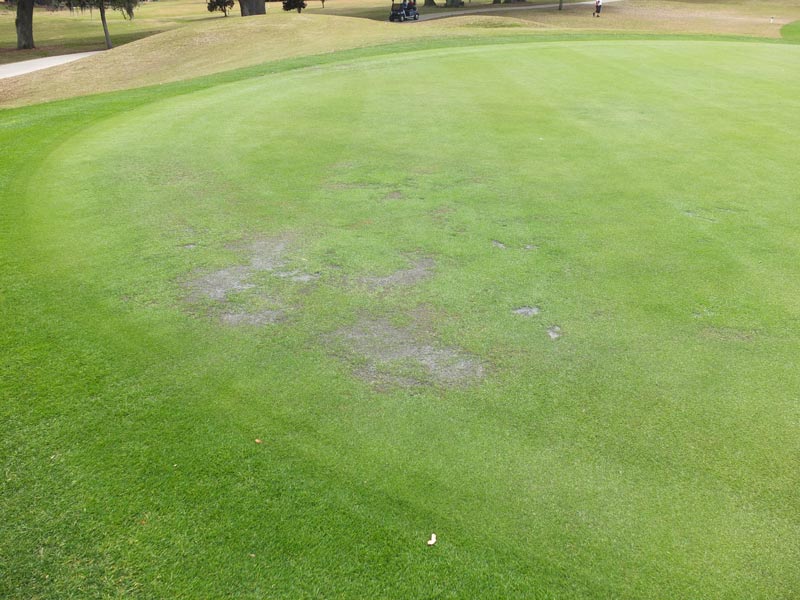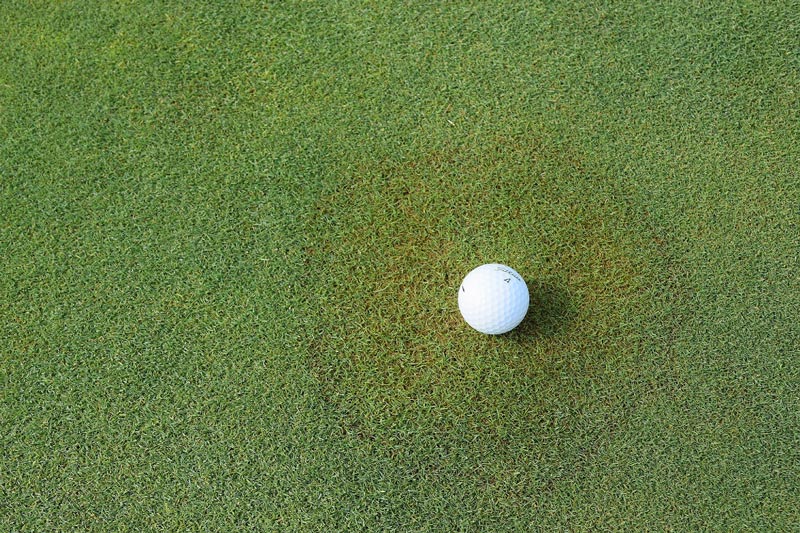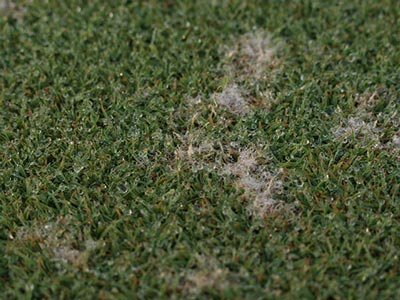
On bermudagrass greens, Pythium blight can look like leaf spot, and both diseases occur at about the same time in the cool months. Photos by the Bayer Green Solutions Team
As summer winds down and the cooler — and often wet — fall weather approaches, golf course superintendents may face many different biotic and abiotic stresses on both warm- and cool-season turf. Regardless of your geographic location, fall turf health preparation is critical for winter survival and optimal playing conditions next spring. Here are a few key points to consider heading into fall to ensure long-term success for both cool- and warm-season turf.
Fall turf prep basics
As soil temperatures start to drop in fall, cool-season turfgrass once again begins to produce root mass for better carbohydrate storage and energy reserve accumulation heading into winter. Optimizing this rooting potential through targeted cultural practices and nutritional supplements is vital for preparing the plant for the stresses that lie ahead.
Winterkill on both cool- and warm-season grasses can be caused by numerous factors (e.g., desiccation, freeze/thaw cycles, crown hydration and direct low-temperature kill), but turf that heads into winter with adequate carbohydrate reserves will ultimately have a competitive edge in such challenging conditions.
Unlocking your turf’s full potential with fungicides and products that deliver plant-health-optimizing benefits can help protect it from the various disease threats. In addition, you can encourage enhanced photosynthetic capabilities as well as better rooting and a stronger, more vigorous stand of turf that’s better prepared to withstand the stresses of the upcoming winter.
Warm-season woes
Bermudagrass bummers
Pythium blight and leaf spot can cause significant problems on bermudagrass greens in fall. These diseases can look very similar and typically start with small, sunken, red-orange to dark gray spots and streaks that can coalesce into greasy-looking patches. Both diseases are problematic with high humidity, extended leaf wetness and cloudy, wet weather.
Along with sound cultural practices, judicious use of Pythium-specific fungicides such as Banol or Segway, phosphonates and phosphites can help preventively mitigate damage from Pythium headed into winter.
Broader-spectrum fungicides such as the DMIs, dicarboxamides or strobilurin families can effectively address leaf spot as well as Microdochium patch. Consider fungicides that provide multiple modes of action along with additional properties for improved turf health, reduced stress and enhanced photosynthesis in this critical time of year.
Zoysia on my mind
Large patch is the most damaging disease of zoysiagrass fairways. Although symptoms appear in late winter and spring, mid-September fungicide applications to fairways and tees are often necessary to deliver complete control. Tebuconazole is highly effective in mitigating large patch, and recent research indicates spray volumes of 2 gallons/1,000 square feet are more effective than 1 gallon/1,000 square feet for large patch control (1).
Cool-season cautions

Brown patch with a prominent smoke ring.
Labor Day lookout
Keep a close watch on summer diseases such as brown patch, Pythium, summer patch, gray leaf spot and anthracnose. Although the weather is changing, sufficient protection is often needed headed into Labor Day weekend and beyond, especially considering the elevated play volume and likelihood of a late-summer heat wave.
Be sure the turf is adequately guarded against the myriad diseases that can linger into late August and early September. This is not a time to take the foot off the pedal and allow for damage to set in that could affect turf health long into the fall and winter months. Remain diligent with program schedules, especially when summer heat and humidity remain in the 10-day forecast. Keeping inoculum under control now should pay dividends next spring.

Right: Dollar spot mycelium on fairway-height creeping bentgrass.
Late-season flare-ups
Dollar spot can be especially problematic in late summer/fall, particularly on cool-season turf. Warm days and cool nights with high dew points favor elevated disease development. Because of the rampant and aggressive nature of fall dollar spot activity, it’s advised to treat late-season epidemics as you would early ones, by keeping inoculum levels low with well-timed preventive applications of effective systemic fungicides.
SDHI chemistries tend to be very effective this time of year. For optimal protection, consider combination products that are enhanced with not only a strong SDHI, but also an additional active ingredient for broad-spectrum disease control. Some fungicides contain additional formulation properties for enhanced benefits such as improved abiotic stress mitigation, quicker dry times, and improved product coverage for added confidence on foliar diseases moving into the cool weather.
Staying a step ahead of snow mold
The snow mold disease complex can devastate turfgrass in northern climates that experience significant snowfall on a yearly basis. In areas with 80-plus days of average snow cover, it’s particularly important to consider a primer fungicide application two to three weeks prior to the final snow mold application for winter.
This “set-up” application has been shown to improve disease control consistency (2), especially during challenging winters in which rainfall, melting events and unseasonable warm-ups encourage fungicide breakdown and subsequent pathogen development. Many fungicide options can be effective. Strobilurins, DMIs and dicarboxamides can all be used to manage late-fall inoculum of both pink and gray snow mold. Combination products offer a one-two punch against these pathogens with the added benefit of formulation enhancements for boosted plant health and turf quality late in the season.
Early fall is an excellent time to stock up on tools for the coming year as well as tools to address immediate needs. With in-season promotions such as Now Solutions and early-order programs on the horizon, golf course superintendents can take advantage of some significant cost savings as they continue to build out a solid preventive program.
- Benelli, J.J., and B.J. Horvath. 2016. Influence of spray rate volume and adjuvant additives on fungicidal control of large patch.
- Vargas, J.M., R. Detweiler and N. Dykema. 2014-2015 snow mold (Microdochium nivale, Typhula ishikariensis) study.
Paul Giordano, Ph.D., is a Bayer Green Solutions Team specialist and has more than 15 years of experience in the turfgrass industry.